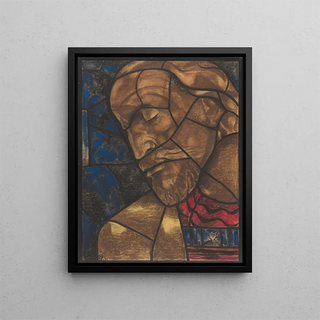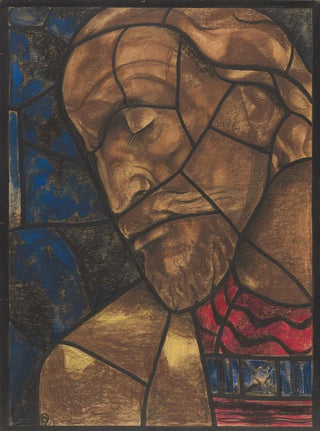Art print | Window project in the north transept of Utrecht Cathedral 26 - Richard Nicolas Roland Holst


View from behind

Frame (optional)
The "Art print Project of the window in the north transept of the Cathedral in Utrecht 26 - Richard Nicolas Roland Holst" is part of an artistic tradition where architecture and art come together to create spaces that are both functional and spiritual. This project, born from the fertile imagination of Richard Nicolas Roland Holst, reflects an era when sacred art played a prominent role in religious architecture. The north transept of the Cathedral in Utrecht, with its rich history and cultural significance, thus becomes the perfect setting for a work that aims to transcend mere decoration to touch the very essence of spirituality.
Style and uniqueness of the work
The style of this piece is characterized by a delicate harmony between geometric shapes and organic motifs, typical of the Art Nouveau movement. Holst, as a master of stained glass, plays with light and color, creating dynamic compositions that invite contemplation. The figurative elements, often inspired by nature, intertwine with abstractions, generating a captivating visual dialogue. This approach allows the artwork to breathe while fitting seamlessly into the architecture of the transept. The subtle color nuances evoke an atmosphere of serenity and mystery, transforming the space into a sacred environment where every glance at the stained glass becomes a spiritual experience.
The artist and his influence
Richard Nicolas Roland Holst, an emblematic figure of Dutch art in the early 20th century, mastered the blend of tradition and modernity in his creations. Influenced by the artistic currents of his time, he developed a personal style that is uniquely his own, incorporating elements of symbolism and Art Nouveau. Holst was also a passionate advocate for applied art, firmly believing that art should be accessible and integrated into daily life. His work on the window project at Utrecht Cathedral exemplifies this vision, where art is not limited to simple representation but becomes an integral part of the human experience. His influence endures, inspiring many contemporary artists seeking to redefine the boundaries between art and architecture.

Matte finish

View from behind

Frame (optional)
The "Art print Project of the window in the north transept of the Cathedral in Utrecht 26 - Richard Nicolas Roland Holst" is part of an artistic tradition where architecture and art come together to create spaces that are both functional and spiritual. This project, born from the fertile imagination of Richard Nicolas Roland Holst, reflects an era when sacred art played a prominent role in religious architecture. The north transept of the Cathedral in Utrecht, with its rich history and cultural significance, thus becomes the perfect setting for a work that aims to transcend mere decoration to touch the very essence of spirituality.
Style and uniqueness of the work
The style of this piece is characterized by a delicate harmony between geometric shapes and organic motifs, typical of the Art Nouveau movement. Holst, as a master of stained glass, plays with light and color, creating dynamic compositions that invite contemplation. The figurative elements, often inspired by nature, intertwine with abstractions, generating a captivating visual dialogue. This approach allows the artwork to breathe while fitting seamlessly into the architecture of the transept. The subtle color nuances evoke an atmosphere of serenity and mystery, transforming the space into a sacred environment where every glance at the stained glass becomes a spiritual experience.
The artist and his influence
Richard Nicolas Roland Holst, an emblematic figure of Dutch art in the early 20th century, mastered the blend of tradition and modernity in his creations. Influenced by the artistic currents of his time, he developed a personal style that is uniquely his own, incorporating elements of symbolism and Art Nouveau. Holst was also a passionate advocate for applied art, firmly believing that art should be accessible and integrated into daily life. His work on the window project at Utrecht Cathedral exemplifies this vision, where art is not limited to simple representation but becomes an integral part of the human experience. His influence endures, inspiring many contemporary artists seeking to redefine the boundaries between art and architecture.






